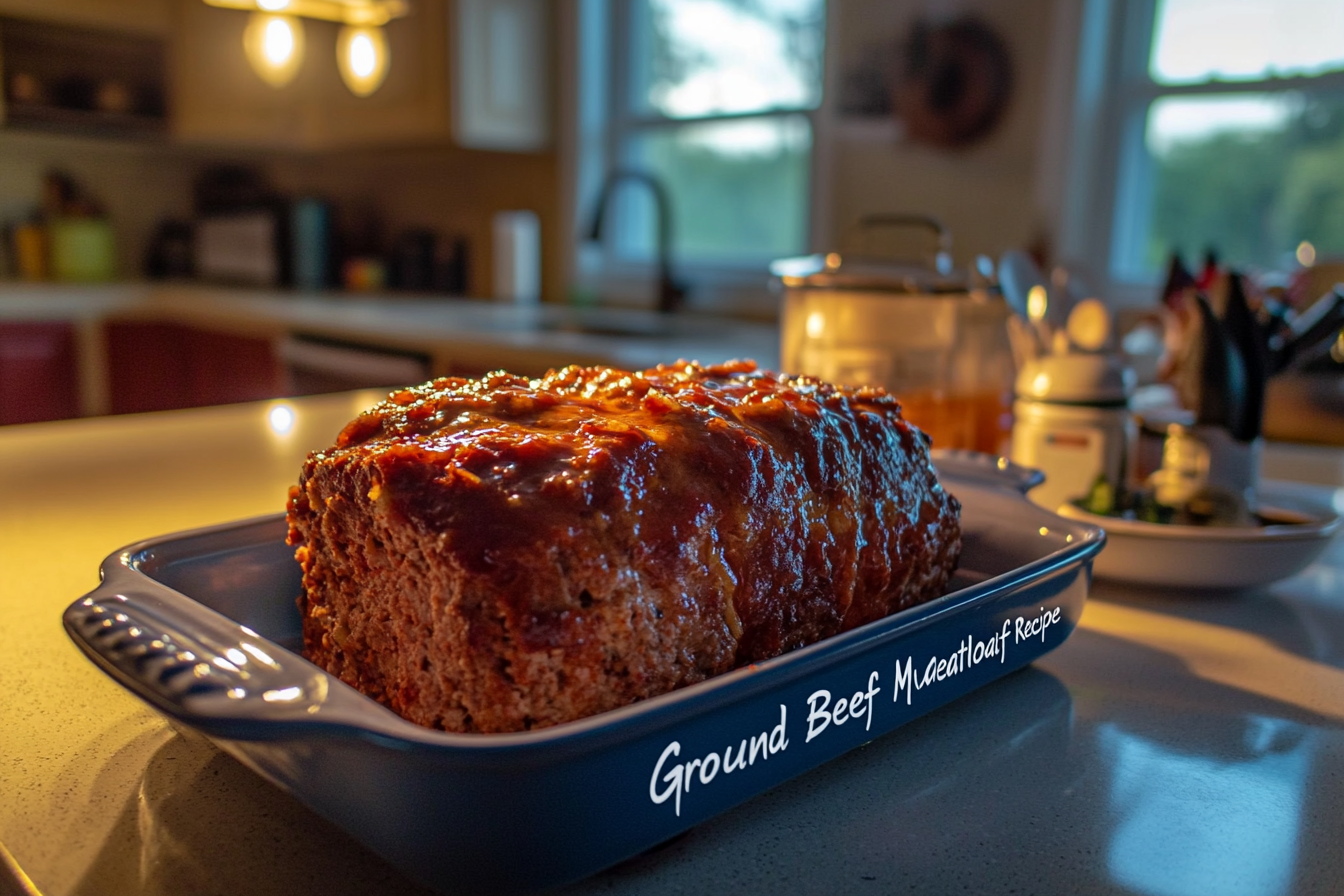Introduction
Ground Beef Meatloaf Recipe has long been considered a comfort food staple, combining simplicity, flavor, and nostalgia in every bite. Its versatility makes it a beloved choice for family dinners, casual gatherings, and even as a meal-prep option for busy weeks. But what exactly makes this dish so iconic?
The history of meatloaf stretches back centuries, with variations appearing in cuisines worldwide. In the United States, the classic ground beef meatloaf recipe gained popularity during the Great Depression as a cost-effective way to stretch ingredients. Internationally, dishes like German Hackbraten and Italian Polpettone show how different cultures have made this humble dish their own.
Ground Beef as the Star Ingredient
The foundation of any great meatloaf is the quality of the ground beef. The texture, flavor, and fat content of the beef can make or break the dish.
- Best Cuts for Ground Beef: While chuck is the most common choice for meatloaf due to its balance of fat and lean meat, some cooks prefer ground sirloin for a leaner option. Mixing cuts can also yield excellent results.
- Fat Content: Ideally, look for an 80/20 ground beef blend. The fat ensures your meatloaf remains moist and flavorful during the cooking process.
Why Make Meatloaf at Home?
Homemade meatloaf offers several advantages over store-bought options. For starters, you have full control over the ingredients, making it possible to cater to dietary restrictions or preferences.
- Cost-Effective: A homemade meatloaf is a budget-friendly meal that can feed an entire family with leftovers to spare.
- Family-Friendly: Its mild flavor and customizable recipe make it appealing to picky eaters. Adding fun shapes or individual portions can even encourage kids to try it.
Essential Ingredients for a Perfect Meatloaf
The secret to a delicious meatloaf lies in a balance of key ingredients:
- Ground Beef for flavor and texture.
- Binders like bread crumbs, oats, or crackers to hold everything together.
- Moisture Agents such as milk, broth, or eggs to prevent dryness.
- Seasonings and Add-ins like onions, garlic, and Worcestershire sauce for depth.
Choosing the Right Ground Beef
Selecting high-quality ground beef is crucial for flavor and safety:
- Lean vs. Fatty Beef: Opt for ground beef with a higher fat content if you want a moist and juicy meatloaf. However, if you’re aiming for a healthier version, choose leaner cuts and incorporate additional moisture agents.
- How to Identify Quality Meat: Look for bright red beef with minimal liquid in the packaging. Fresh ground beef should have a mild smell and a consistent texture.
The Role of Binding Agents
Binding agents are essential for keeping your meatloaf intact:
- Bread Crumbs vs. Oats: Bread crumbs create a denser loaf, while oats lend a slightly softer texture. Choose based on personal preference.
- Egg Substitutes: For those avoiding eggs, alternatives like flaxseed meal mixed with water or unsweetened applesauce can provide similar binding properties.
Preparation Essentials
Setting up your kitchen with the right tools ensures a smoother cooking experience:
- Tools to Have on Hand:
- A large mixing bowl for combining ingredients.
- A loaf pan or baking sheet to shape the meatloaf.
- A meat thermometer to ensure it’s cooked through.
- Cleanup Tips: Line your pan with parchment paper or aluminum foil to reduce sticking and simplify cleanup.
Flavor-Boosting Additions
Elevate your meatloaf by incorporating additional flavors and textures:
- Vegetables: Diced onions, bell peppers, and shredded carrots not only enhance flavor but also add moisture.
- Cheese and Bacon: A layer of cheese in the center or a bacon wrap around the loaf adds indulgence and depth.
Common Mistakes to Avoid
Even seasoned cooks can stumble upon a few pitfalls when making meatloaf:
- Overmixing: Handling the meat mixture too much can lead to a dense and tough texture.
- Skipping the Meat Thermometer: Always check the internal temperature (160°F for beef) to ensure it’s fully cooked without drying out.
The Versatility of Meatloaf
One of the reasons meatloaf remains popular is its adaptability:
- Meal Prep Friendly: Make a large batch, slice it, and store it in the freezer for quick meals.
- Pairing Suggestions: Serve with mashed potatoes, roasted vegetables, or a crisp salad for a well-rounded plate.
Experiment with flavors to suit any occasion, from weeknight dinners to holiday feasts.
Part 2: Step-by-Step Recipe and Variations
Classic Ground Beef Meatloaf Recipe
The classic ground beef meatloaf recipe is beloved for its simplicity and flavor. Perfect for both beginners and seasoned cooks, it uses basic ingredients that are likely already in your kitchen.
- Ingredients:
- 2 pounds ground beef (80/20 blend)
- 1 cup bread crumbs
- 2 large eggs
- 1 medium onion, finely diced
- 3 cloves garlic, minced
- 1/2 cup milk or broth
- 1 tablespoon Worcestershire sauce
- 1/3 cup ketchup
- Salt and pepper to taste
- Prep Time: 15 minutes
- Cook Time: 1 hour
- Yield: Serves 6-8
Discover more tips on making family meals quick and easy.
Prepping the Ingredients
Preparation is key to ensuring your meatloaf turns out perfectly:
- Dicing Onions and Garlic: Chop onions finely to avoid large chunks in the loaf. Minced garlic enhances flavor but can be substituted with garlic powder for convenience.
- Measuring Spices and Bindings: Have all your ingredients pre-measured to streamline the process and ensure accurate proportions.
Step 2: Mixing the Meatloaf
The mixing stage determines the texture and taste of your meatloaf:
- Combine in the Right Order: Begin by mixing the wet ingredients (milk, eggs, and Worcestershire sauce) with spices. Gradually fold in bread crumbs and ground beef to avoid overmixing.
- Perfect Texture: The mixture should be moist but firm enough to hold its shape. Add bread crumbs or milk as needed to adjust consistency.
Step 3: Shaping and Baking
Once mixed, shaping and baking require attention to detail for even cooking:
- Shaping: Place the mixture in a loaf pan or shape it by hand on a baking sheet. Ensure uniform thickness to avoid uneven cooking.
- Baking Tips: Preheat your oven to 350°F (175°C) and bake for approximately 1 hour. Use a meat thermometer to check for an internal temperature of 160°F.
Step 4: Adding the Glaze
The glaze is a defining feature of a classic meatloaf, adding a tangy-sweet layer of flavor:
- Classic Glaze: Mix ketchup, brown sugar, and a splash of vinegar. Spread it evenly over the meatloaf during the last 15 minutes of baking.
- Alternative Toppings: Experiment with barbecue sauce, honey mustard, or marinara for a unique twist.
Creative Variations
If you want to take your meatloaf to the next level, try these creative spins:
- Cheese-Stuffed Meatloaf: Add a layer of shredded cheese in the center of the loaf for a gooey surprise.
- BBQ-Style Meatloaf: Replace ketchup with your favorite barbecue sauce and add smoked paprika for a smoky flavor.
Low-Carb or Keto-Friendly Adaptations
For those on a low-carb or keto diet, meatloaf can be easily adjusted:
- Binders: Substitute traditional bread crumbs with almond flour or crushed pork rinds.
- Glaze: Use sugar-free ketchup or skip the glaze altogether for a savory loaf.
Mini Meatloaf Recipes
Mini meatloaves are ideal for portion control and quicker cooking:
- Using Muffin Tins: Divide the mixture evenly into muffin tins for individual servings. Bake at 350°F for 20-25 minutes.
- Adjustments: Reduce cooking time proportionally for smaller sizes to avoid drying out.
Vegetable-Packed Meatloaf
Adding vegetables is a great way to boost nutrition and flavor:
- Shredded Additions: Carrots, zucchini, and spinach blend seamlessly into the meat mixture. Ensure they’re well-drained to prevent excess moisture.
- Fresh Herbs: Use parsley, thyme, or oregano to enhance the overall flavor profile.
How to Freeze and Reheat Meatloaf
Meatloaf is a freezer-friendly dish that retains its quality when stored properly:
- Freezing Tips:
- Wrap the cooked or uncooked meatloaf tightly in plastic wrap and foil.
- Label it with the date for reference.
- Reheating: For best results, thaw frozen meatloaf in the refrigerator overnight. Reheat in the oven at 325°F until warmed through.
Making Meatloaf Ahead of Time
Planning ahead makes meatloaf a convenient option for weeknight dinners:
- Storing Raw Mixture: Prepare the meat mixture and store it in the refrigerator for up to 24 hours before baking.
- Quick Dinners: Assemble and freeze individual portions for easy reheating on busy nights.
Part 3: Nutrition, Tips, and Pairings
Nutritional Profile of Ground Beef Meatloaf
Meatloaf is not just hearty and delicious—it can also be nutritious when prepared thoughtfully. Understanding its nutritional content helps tailor it to fit your dietary needs.
- Calories and Macronutrients: A standard slice of meatloaf (using 80/20 ground beef) contains approximately 250-300 calories, with 14-16 grams of protein and 15-20 grams of fat. The carb content largely depends on the type and amount of binding agents used.
- Healthier Ingredient Swaps:
- Use lean ground beef or ground turkey to reduce fat.
- Replace breadcrumbs with almond flour or oats for a fiber boost.
- Incorporate nutrient-dense vegetables like spinach or bell peppers.
Learn more about balancing comfort food with health.
Tips for a Moist and Flavorful Meatloaf
A perfect meatloaf is moist, tender, and packed with flavor. Follow these expert tips to achieve the ideal loaf:
- Use Milk or Broth: Adding milk or broth ensures the mixture remains moist, especially when using leaner meats.
- Avoid Overcooking: Overbaking leads to dryness. Monitor the internal temperature (160°F for beef) closely with a meat thermometer.
- Don’t Skimp on Seasoning: Ground beef benefits from bold flavors. Incorporate a mix of spices, fresh herbs, and umami-rich ingredients like Worcestershire sauce or soy sauce.
Choosing the Perfect Side Dishes
Meatloaf pairs well with a variety of sides that complement its hearty texture and savory flavors:
- Classic Options:
- Mashed potatoes and gravy.
- Buttered green beans or steamed broccoli.
- Healthier Choices:
- Roasted sweet potatoes.
- A fresh garden salad with a light vinaigrette.
Explore creative side dish ideas here.
Serving Meatloaf for Different Occasions
While meatloaf is often associated with casual family dinners, it can easily be adapted for various events:
- Family Dinners: Serve with mashed potatoes and a vegetable medley for a comforting weeknight meal.

